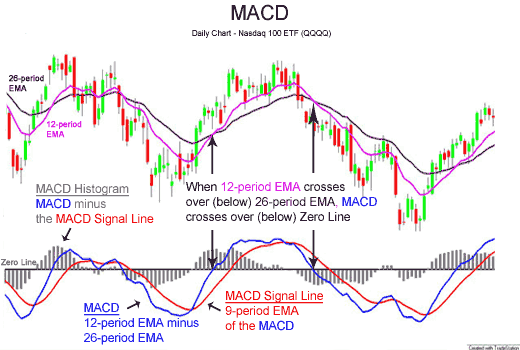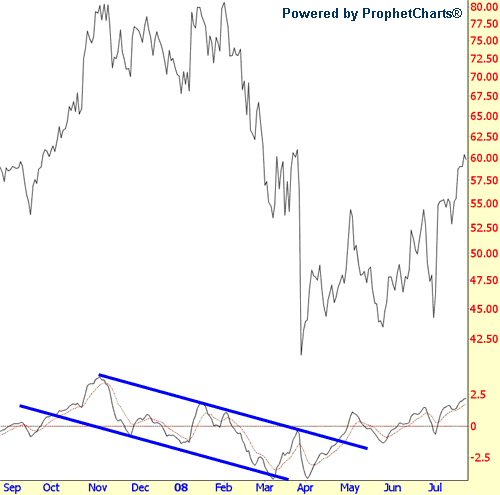Created by Gerard Appel in the 1970's with the histogram added by Thomas Aspray in the 1986, the MACD used historical data in the form of closing prices to notify traders of potential changes in trend or momentum. For starters, the MACD is calculated by subtracting the 26 period EMA (exponential moving average) from the 12 period EMA. Then a 9 period EMA is plotted over the MACD, serving as a buy/sell signal when it crosses. When the EMA's are diverging, momentum is increasing and as they are converging momentum is decreasing. As taken from the Wikipedia page:
Above is a MACD of the Nasdaq 100 ETF, showing different crosses that occur from the MACD indicator. The Histogram, the bars on the zero line, represents the difference between the MACD and the MACD signal line, the 9 period EMA of the MACD.
Three common ways of using the MACD are: 1) crossovers 2) divergence and 3) dramatic rises. Crossovers occur when the MACD line crosses over the 9 period signal line; when the MACD line rises above the signal line it is a buy signal and when the MACD drops beneath the signal line it is a sell signal. These are only one examples of signals, however, and are not reliable when not used in conjunction with other signals that may come later. Divergence occurs when the price action diverges from the MACD, signalling that the current trend is likely to end.
Dramatic rises are also an important part of the analysis of the MACD. Dramatic rises are characterized by movements of the shorter period EMA pulling away from the longer period EMA very quickly, signaling that it is overbought and will return to normal conditions eventually. Something else that is important to look out for while using the MACD indicator is movement of the MACD through the zero line. When the MACD is above the zero line it indicates an upwards trend and while it is below the zero line it is in a downtrend. The areas above or below the zero line can also be used as reference to support and resistance areas. When the MACD is returning to the zero line it is a sign of potential weakening of the trend.
Advantages to using the MACD: a simple indicator with a lot to offer, mastering the MACD is not a very labor-intensive process but can bring about sizable rewards.
Drawbacks to using the MACD: whipsaws and false signals are common, making it difficult to hold a profit if fees and commission are part of your trading. Using longer time frames in your analysis can minimize the impact of whipsaw.
Additional chart to help you understand how channeling the movement of the MACD indicator can give you the jump on when a trend is reversing



No comments:
Post a Comment